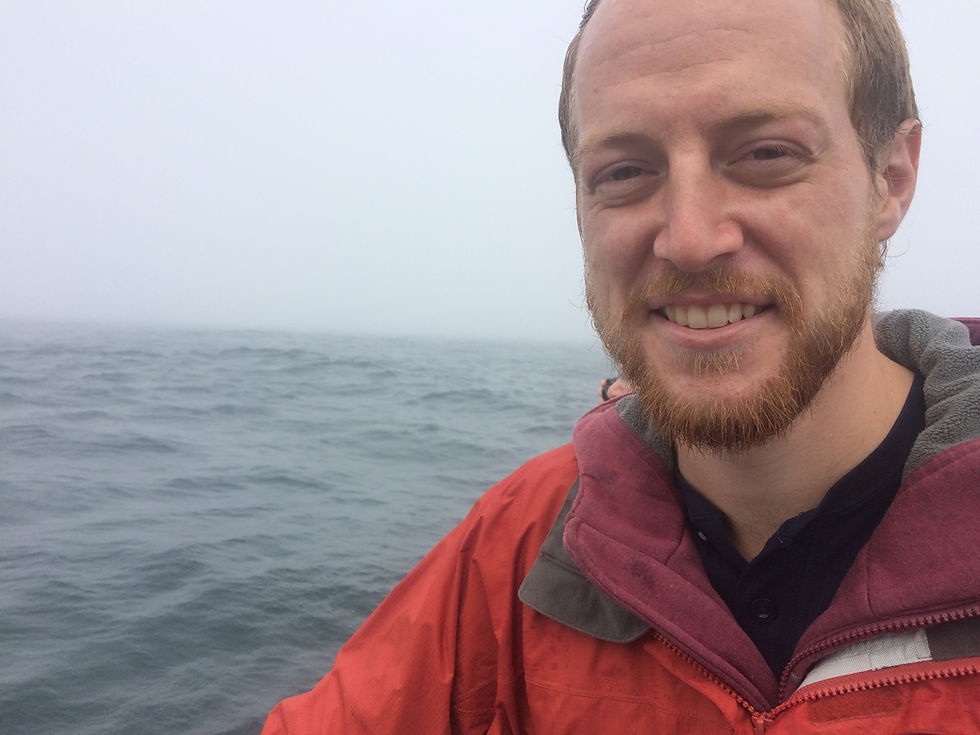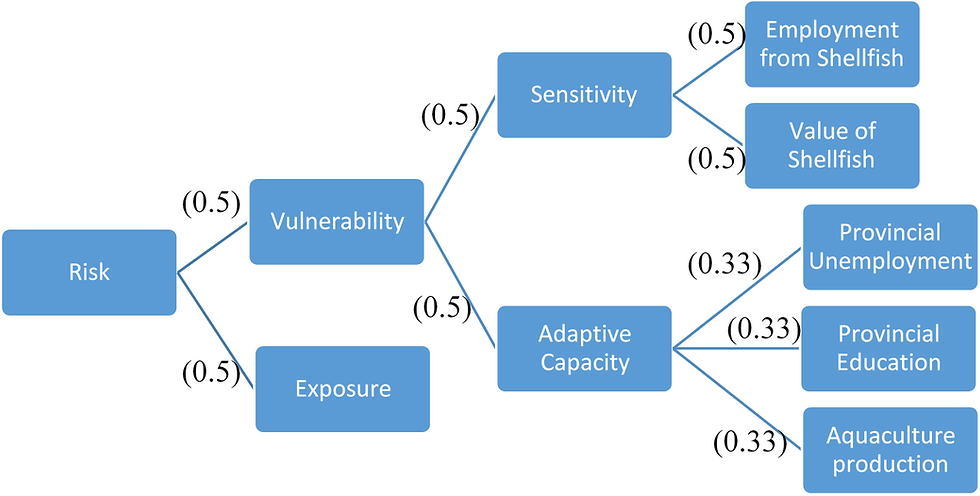Ocean acidification (OA) is expected to have negatives consequences for many marine organisms, particularly shellfish that build their hard parts from calcium carbonate. But what about the communities and people that depend on these potentially vulnerable organisms as part of their livelihoods and local economies? We spoke with two researchers, Tyler Wilson and Dr. Travis Tai, on a new paper examining the possible socioeconomic effects of climate change and OA on fisheries in Atlantic Canada (Wilson et al., 2020).
Tyler Wilson, lead author of the study, conducted this research as part of his Master’s degree in Environmental Studies under the supervision of Dr. Peter Tyedmers at Dalhousie University (Halifax, N.S.). Mr. Wilson is currently working for Fisheries and Oceans Canada (DFO) on a Live Gene Banking program for endangered Inner Bay of Fundy Atlantic Salmon. Prior to starting his graduate work, Mr. Wilson, who completed an undergraduate degree in Biology and Ocean Sciences at the University of Victoria, worked on salmon stock assessment for DFO in B.C.. Through his undergraduate degree, he began to see OA as a sort of “hidden” aspect of climate change that, while tangential to his main studies, drew his interest to pursue a graduate program that would allow him to examine some of the socio-economic impacts of OA (as part of the Canadian Ocean Acidification Research Program [COARp], funded by MEOPAR).

Dr. Travis Tai, a co-author who conducted the species distribution modelling work underpinning the study, also works on OA and climate change impacts on fisheries species. Dr. Tai’s background is in OA, climate change, fisheries, biological responses, and integrated modelling. He is currently working as a postdoctoral researcher at the Pacific Climate Impacts Consortium, investigating climate change risk on freshwater life stages in Pacific salmon.

“My research interests are on climate change and ocean acidification impacts on living marine organisms, and largely species of commercial value (i.e. fisheries),” Dr. Tai writes.
“I use a variety of approaches to model how changes in environmental conditions due to anthropogenic accelerated climate change affect the biology, abundance, and distribution of marine species. One of these approaches includes integrating models of physiology, biology, population dynamics, and spatial movement to project future distribution and abundance. I also work on developing methods and frameworks—using various indicators of physical and biological change—to determine the relative risk of marine species to climate change.”
With the help of Dr. Tai and other co-authors, Mr. Wilson set out to explore and produce a broad-scale picture of the effects of climate change and OA on fisheries, particularly the potential for impact on rural coastal communities and their economies in Atlantic Canada. The goal of the paper was to bring together both the potential biological and societal outcomes to answer the question:
How will OA and climate change affect Canadian Atlantic Fisheries and their associated communities?

“This study was built on previous modelling work on biological responses to ocean acidification and climate change of commercially valuable species,” says Dr. Tai.
“We were interested in producing a more interdisciplinary approach to assess the impacts of climate change at the species level and how it carries over to impacts on society. One of the ways we can prepare for the impacts of climate change is through preparedness and developing plans and efforts to mitigate impacts. Exercises such as these provided in this study allow us to better understand the potential impacts of climate change on fisheries, given our current understanding of the underlying processes.”
The study implemented an impact assessment framework that used models of species distributions to inform and assess potential future socioeconomic outcomes of climate change and OA.
“We used a combination of modelling techniques in this study. First, we used species distribution models for changes in distribution and abundance of species populations. The outputs from these models were then used as inputs for measuring downstream effects on society. [Second], we used indicators for economic and societal impacts to gauge the overall risk of ocean acidification and climate change to fisheries,” Dr. Tai explains.
Mr. Wilson says they built off socioeconomic indicators used in several previous papers. The indicators used in the study covered both economic and societal impacts, including metrics such as landings values, the number of fishing licences issued, and Statistics Canada data on unemployment and education. Mr. Wilson says that they also looked at how important fisheries were to local communities by looking at percentage changes, rather than just dollar values. These indicators were combined with the models of species distributions to assess the socioeconomic risks to Atlantic provinces and fishing regions.

“We found that ocean acidification presents a relatively small impact to shellfish fisheries sectors in Atlantic Canada, but amount to much greater risk when compounded with other effects of climate change, particularly ocean warming. Provinces such as Nova Scotia and New Brunswick will see changes in resource availability, but have relatively high adaptive scores and [are] socially and economically robust to these impacts. Conversely, the provinces PEI and Newfoundland and Labrador scores lower in terms of adaptive capacity, but are projected to see smaller changes to species populations in their adjacent fishing regions,” writes Dr. Tai.
Surprisingly, these results were not “hugely dramatic” with respect to OA, Mr. Wilson points out. While the model projections did show some decreases in some fisheries stocks, not all of the outcomes were negative. For example, snow crab were hardest hit in the model projections and declined across the region, but as this species relies on colder temperatures, the results were not surprising. Conversely, some species were expected to see net increases in the region as a whole (with more localised declines). Overall, they found that OA was not as big of a driver of change as other climate change factors, such as warming temperatures.
Dr. Tai also found the results unexpected.
“One of the major surprises from our results was the relatively small effect of ocean acidification on species distribution and abundance,” he says. “While it is well known that temperature is one of the most important biological drivers, we expected ocean acidification to have considerable impacts on survival. However, our modelling results show that ocean acidification will largely have negative impacts on fisheries species but in most cases will be overshadowed by temperature induced changes.”
With issues like climate change and ocean acidification, there is going to be some change, but it is also important to be aware of some potential opportunities that might be created, Mr. Wilson suggests. For example, their projections indicate increases in lobster stocks as a potential “silver-lining” for Atlantic Canada. However, this comes at a cost to fisheries in the U.S., because as the species’ range shifts northward, fisheries at the southern portion of their range will be negatively impacted. These “positive” outcomes for Atlantic Canada could also be potentially short-lived if the timeline is increased, Mr. Wilson indicates.

Mr. Wilson points out that their results indicate why it is important to take big picture approaches in fisheries management. Not only should there be a push for more diverse management practices, but trans-boundary management between provinces and countries should be considered to capture the larger picture of climate change impacts. Including additional climate change variables in models is also important, rather than just focusing on OA. OA is happening in a larger context of global change, after all, and other factors, such as temperature, could be more important drivers of change than OA, at least in the short term.
“Ocean acidification and climate change [are some] of the biggest threats to our oceans,” Dr. Tai adds. “Understanding how these environmental changes will affect natural resources that we depend on is essential for mitigation and adaptation.”
While the overall results of the study may sound like good news for Atlantic Canada, Mr. Wilson cautions that it is important to “look down the road, rather than just at this year’s catch.” These “positive” outcomes might only be temporary. Should current projections of climate change and OA continue and species keep moving further north or into deeper waters (or start to lose their ideal habitats), we could still see negative consequences for Atlantic Canadian fisheries in the long term.
Read Wilson et al., 2020 here (open access):
Citation: Wilson TJB, Cooley SR, Tai TC, Cheung WWL, Tyedmers PH. 2020. Potential socioeconomic impacts from ocean acidification and climate change effects on Atlantic Canadian fisheries. PLoS ONE 15(1): e0226544.
Acknowledgments:
Thanks to Tyler Wilson for his virtual “in-person” interview, and to Dr. Travis Tai for providing written responses to our questions.
To learn more about Dr. Travis Tai and his research, please visit his Research Gate and Google Scholar profiles.
Comments